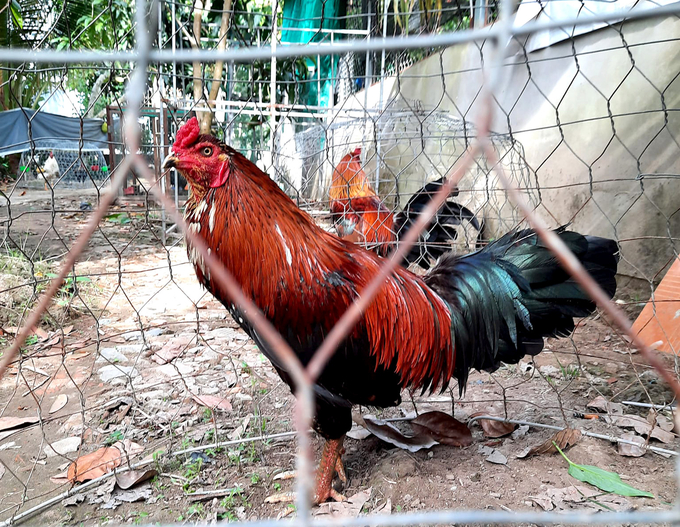
According to the Dong Thap Department of Livestock and Veterinary Medicine, avian flu vaccination coverage is less than 10% across the province and as low as 3-4% in some localities. Picture: Minh Sang.
According to the Ministry of Animal Health, immediately after Prey Veng Province (Cambodia) discovered a human death caused by A/H5N1 avian influenza virus, the Ministry of Agriculture and Rural Development issued an urgent message to prevent smuggling on February 23, 2023 and illegal transportation of poultry and poultry products smuggled into Vietnam from abroad
At the same time, the Ministry of Animal Health in Dong Thap Province set up working groups to coordinate disease prevention and control and control the transportation of poultry and poultry products.
In the past, the Department of Animal Health has also organized the implementation of the avian influenza active surveillance program sponsored by the US Centers for Disease Control. Accordingly, samples were taken from 117 poultry markets, trade and extermination sites in 25 provinces and cities, for a total of 6,158 combined samples (equivalent to 30,790 poultry).
Test results: 2,417 pooled samples were positive for avian influenza type A (39.25%), 361 samples were positive for avian influenza A/H5 (5.86%), 265 samples were positive for avian influenza A/H5N1 (4.3%). , 32 samples were positive for influenza A/H5N6 (equivalent to 0.51%), 13 samples were positive for avian influenza A/H5N8 (equivalent to 0.21%).
Avian influenza virus genetic sequencing results collected in 2021-2022 show the following: Influenza A/H5N1 virus belongs to clade 2.3.2.1c and 2.3.4.4b; A/H5N6 influenza virus belongs to branch 2.3.4.4g and 2.3.4.4h; Influenza A/H5N8 virus belongs to branch 2.3.4.4b. The analysis results also show that there is not much difference in the circulating branches of the avian influenza virus compared to 2019-2020. Specifically, the sample was not found positive for influenza A/H7N9 virus (the strain that causes human disease in China).
The Department of Epidemiology (Department of Animal Health) said the virus strain that caused the recent death in Cambodia belongs to the 2.3.2.1c branch, which is circulating in countries in the region, including Vietnam. This is not a new virus strain.
Cambodian authorities have screened and tested everyone who has been in contact with the deadly bird flu, all with negative results. Therefore, to date, there has been no human-to-human transmission of bird flu. Therefore, if we encourage vaccination and control disease in poultry well, we can prevent the risk of transmission of avian influenza from animals to humans.
After the Department of Agriculture and Rural Development issued Urgent Notice 1030/CD-BNN-TY on February 26, 2023, many locations in the South have urgently stepped up surveillance and prevention of avian influenza.
In Can Tho, on March 6, 2023, the whole city launched a campaign to destroy the environment. In the past, Can Tho’s agricultural sector has also monitored the spread of the bird flu virus in the region and collected 936 samples. The monitoring results showed that no circulating strains of influenza virus A/H5N8 and H7 were detected.
Although poultry flocks traded, transported and slaughtered in poultry slaughterhouses in Can Tho have been infected with influenza A relatively frequently, the infection rate of virulent strains such as H5N1, H5N6, which cause disease, is high very low for poultry and humans. However, the risk of bird flu emerging and spreading in many provinces and cities is very high when vaccination rates are still low.
Mr. Vo Be Hien, director of Dong Thap Animal Husbandry and Veterinary Division, said that the vaccination rate against avian influenza has reached less than 10% across the province and only 3-4% in some places. The main reason is that chickens in Dong Thap are mostly kept on small farms.
Small livestock farming is also a potential source of bird flu outbreaks in the southeastern provinces. According to the Binh Phuoc Ministry of Agriculture and Rural Development, while livestock farms actively organize and carry out vaccination against dangerous diseases, including avian flu, the facility’s vaccination procedure with the vaccination rate reaches 100% of the entire small livestock herd households with shabby barns, difficult to apply Biosecurity measures … which means that the risk of disease incursion and occurrence is very high, especially when some places of animal husbandry and veterinary work in the region have not really paid attention.

